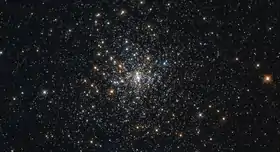| NGC 6325 | |
|---|---|
 NGC 6325 as seen through the Hubble Space Telescope | |
| Observation data (J2000 epoch) | |
| Class | IV[1] |
| Constellation | Ophiuchus |
| Right ascension | 17h 17m 59.27s[2] |
| Declination | −23° 45′ 57.7″[2] |
| Distance | 25,400 ly (7,800 pc)[1] |
| Apparent magnitude (V) | 10.33[3] |
| Apparent dimensions (V) | 4.3′ × 4.3′[1] |
| Physical characteristics | |
| Metallicity | = -1.25[3] dex |
| Other designations | GCl 58, ESO 519-11[2] |
NGC 6325 is a globular cluster located in the constellation Ophiuchus. Its Shapley-Sawyer Concentration Class is IV, meaning that it has "intermediate rich concentration"; it was discovered by the British astronomer John Herschel on 24 May 1835. It is at a distance of about 25,000 light years away from Earth.[4]
See also
References
- 1 2 3 Hartmut Frommert. "NGC 6325 - Hartmut Frommert - SEDS". SEDS. Retrieved 6 February 2017.
- 1 2 3 "NGC 6325". SIMBAD. Centre de données astronomiques de Strasbourg. Retrieved 8 February 2017.
- 1 2 William E. Harris. "Catalog of Parameters for Milky Way Globular Clusters". Retrieved 3 February 2017.
- ↑ "NGC 6325 (= GCL 58)". cseligman. Retrieved 8 February 2017.
External links
 Media related to NGC 6325 at Wikimedia Commons
Media related to NGC 6325 at Wikimedia Commons
This article is issued from Wikipedia. The text is licensed under Creative Commons - Attribution - Sharealike. Additional terms may apply for the media files.